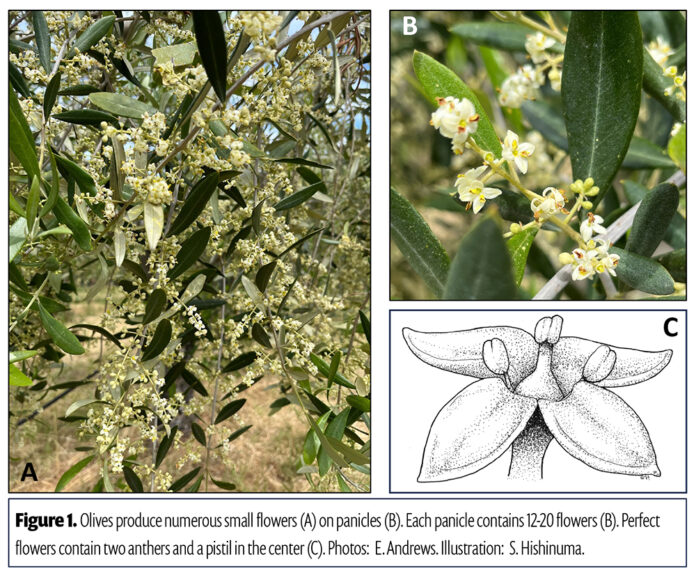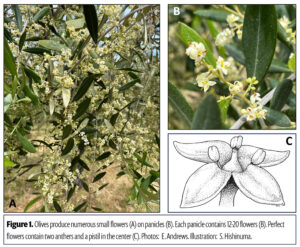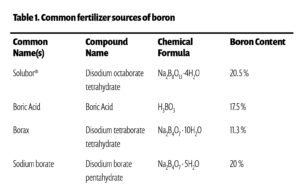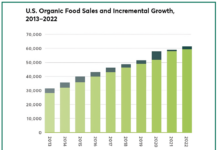
Olive orchards entering an ‘off’ year in 2024 may benefit from pre-bloom foliar boron applications to support reproduction and yield. Because the 2023 California olive crop varied widely both within and between olive-growing regions, the value of B applications should be considered at the individual orchard level. For example, in the southern San Joaquin Valley, the 2023 ‘Manzanillo’ table olive crop was off due to the high temperatures at bloom whereas many oil cultivars in the region were unaffected by the heat and had heavy production. Those orchards that had a heavy ‘on’ crop in 2023 may benefit from pre-bloom B application in the 2024 season.
B is an essential micronutrient for plant growth and reproduction. B deficiency affects plant reproduction by reducing pollen viability and germination and limiting pollen tube growth. Deficiency also limits the proportion of flowers that set fruit and reduces the retention of developing fruit. The influence of B deficiency on multiple stages of reproduction may negatively impact yield. B also plays a role in vegetative growth and metabolism, ensuring cell wall and membrane integrity and facilitating sugar transport and cell division. Because it plays a crucial role in reproduction, B is translocated from vegetative tissues to reproductive tissues, resulting in higher concentrations of the nutrient in reproductive organs than leaves. Due to this high demand, reproductive B deficiency can occur even when vegetative B and available soil B are sufficient.

Benefits of Boron
Studies conducted across numerous global olive-growing regions demonstrate the beneficial effects of foliar B application on yield, particularly in advance of an off crop. The influence of B application on productivity in olive orchards may relate to increases in photosynthesis, an increase in the number of perfect flowers (those with both male and female reproductive parts) (Figure 1) and an increase in pollen viability, or pollen tube growth. Olives are considered andromonoecious, a reproductive strategy in which plants bear both hermaphroditic (perfect) flowers and male flowers. Stress prior to bloom may cause pistil abscission in a fraction of buds resulting in a higher percentage of male flowers. Several research studies have demonstrated pre-bloom foliar B application can increase the percent of perfect flowers on trees, thus increasing the number of flowers capable of producing fruit. In olive, B is readily mobilized from both young and old vegetative growth to support flower and fruit production; therefore, a portion of B applied throughout the year may be utilized to support reproductive processes. During the pre-bloom season, however, cool temperatures and the corresponding reduced physiological activity may limit the uptake and translocation of B in olive. Additionally, flowers are not as strong a B sink as fruit; therefore, the pre-bloom foliar application may render the micronutrient available at a short-lived yet critical time in crop development.

Both oil olives and ‘Manzanillo’ table olives have been shown to benefit from foliar B applications. For example, ‘Arbequina’ receiving pre-bloom foliar application of B exhibited increased bloom and a 27% increase in yield in an off year. In the ‘Arbequina’ study, no value of B was observed in an on year, and B was found to have no effect on vegetative growth. In another study, B applications to ‘Frantoio’ resulted in increased concentration of chlorophyll and soluble sugars as well as changes in the profile of endogenous plant growth regulators within the leaves. In California, pre-bloom B applications on ‘Manzanillo’ resulted in increased percentage of perfect flowers and improved fruit set and yield, particularly during an off year.
Recommended Application
The recommended foliar B concentration for olives ranges from 19 to 150 ppm. Values below 14 ppm B may result in B deficiency, whereas values above 185 ppm may result in B toxicity. A foliar nutrient analysis only provides a snapshot of the status of the plant at the time of leaf collection; however, low B status of leaves has been found to correlate well with symptoms of deficiency. Symptoms of B deficiency in olive include dead leaf tips with a characteristic yellow band and green leaf base as well as twig and limb dieback (Figure 2). B deficiency may first become apparent in the meristems, the growing tips of shoots. B deficiency may also result in misshapen and defective fruit (Figure 2), low fruit set and premature fruit drop. The value of B application for improved fruit set is not limited to orchards with visual symptoms of B deficiency or foliar B levels below the recommended range. In fact, the numerous research studies that demonstrate the value of pre-bloom foliar B applications for enhanced fruit set and yield were conducted in orchards with no B deficiency. Based on these findings, foliar analysis alone may not be a useful predictor of benefits from pre-bloom foliar B application.

B is typically introduced to orchards either as a solid mineral broadcast on the soil surface, or in solution as a foliar spray. The pre-bloom foliar application is designed to specifically enhance fruit set and yield and should be applied three weeks prior to bloom. B is generally sold as borax, sodium borate, sodium tetraborate, boric acid, or Solubor® (Table 1). The B content varies between formulations; therefore, all calculations should be based on the equivalents of active ingredient (i.e., pounds of B). For example, for soil-applied B in olive, 5 to 10 lbs/acre B is broadcast, which equates to approximately 45 to 49 lbs/acre borax (11% B) or 24 to 48 lbs/acre Solubor® (20.5% B). In California, foliar application of B three weeks prior to ‘Manzanillo’ bloom, particularly in off years, at rates of 1 or 2 lb./acre Solubor® in a 100 gallon/acre (246 or 491 mg/L B at 935 L/hectare) was demonstrated to improve yield by approximately 30%. The baseline B level in this California study site was 16 ppm B, a level just below the established critical level, but high enough to avoid deficiency symptoms.
The value of B applications on orchard health and economic return varies based on the status of the alternate bearing cycle in the year of application, the baseline B status of the tree and soil, and other climate factors that may influence yield. Plants have a narrow range between B deficiency and toxicity. Be sure to read the product label carefully to avoid over-application and conduct annual leaf tissue analyses to gather baseline information on the B status of orchards. More information on fertilizer rates for olives and other California crops may be found on the CDFA FREP California Crop Fertilization Guidelines website at cdfa.ca.gov/is/ffldrs/frep/FertilizationGuidelines/.













